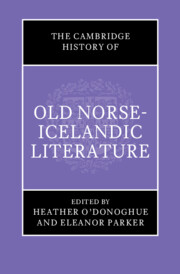Book contents
- The Cambridge History of Old Norse-Icelandic Literature
- The Cambridge History of Old Norse-Icelandic Literature
- Copyright page
- Contents
- Contributors
- Abbreviations
- Introduction
- Part I Contexts
- 1 History
- 2 Manuscripts and Textual Culture
- 3 Poetic Language, Form and Metre
- 4 Theoretical Approaches
- 5 Reception
- 6 Landscape and Material Culture
- Part II The Distant Past
- Part III The Saga Age
- Part IV The New Christian World
- PART V Beyond Iceland
- Part VI Compilations
- Glossary
- Bibliography
- Index
1 - History
Iceland from the Settlement to 1400 CE
from Part I - Contexts
Published online by Cambridge University Press: 08 February 2024
- The Cambridge History of Old Norse-Icelandic Literature
- The Cambridge History of Old Norse-Icelandic Literature
- Copyright page
- Contents
- Contributors
- Abbreviations
- Introduction
- Part I Contexts
- 1 History
- 2 Manuscripts and Textual Culture
- 3 Poetic Language, Form and Metre
- 4 Theoretical Approaches
- 5 Reception
- 6 Landscape and Material Culture
- Part II The Distant Past
- Part III The Saga Age
- Part IV The New Christian World
- PART V Beyond Iceland
- Part VI Compilations
- Glossary
- Bibliography
- Index
Summary
This overview of Iceland’s medieval history is divided into three phases: firstly, from settlement in the ninth century to 1096−7, which marks the emergence of the Icelandic Church; secondly, from the appearance of Iceland’s earliest written historical sources to the ceding of independence to Norway in 1262/4; and finally, to the end of the fourteenth century. It shows how Iceland’s marginality to the rest of Europe, its lack of a centralized authority and the blurring of historicity and fiction in its most prominent texts have affected understanding of Icelandic history and problematized its historiography. The chapter begins with discussion of the two primary native sources, Ari Þorgilsson’s Islendingabók (The Book of Icelanders) and Landnámabók (The Book of Settlements), their accounts of settlement and conversion, and the value of archaeology as a source. The second phase details the growth of the church and monasteries as places of learning, and how the church’s increasing power led to clashes with the secular elite, resulting in the chaos and violence of the Sturlungaöld. The final phase concerns Iceland’s loss of independence, economic condition and relations with Norway.
Keywords
- Type
- Chapter
- Information
- The Cambridge History of Old Norse-Icelandic Literature , pp. 11 - 32Publisher: Cambridge University PressPrint publication year: 2024

